Weedy Hosts of the Diaprepes Root Weevil in Florida Sugarcane
Sugarcane (Saccharum spp. interspecific hybrids) is Florida’s most valuable field crop cultivated on organic soils in the Everglades Agricultural Area and surrounding mineral soils in southern Florida. Several insect pests can affect production and profitability of sugarcane. The most important insect pests in Florida sugarcane are wireworms, white grubs, lesser cornstalk borer, sugarcane borer, and yellow sugarcane aphid (Beuzelin et al. 2019). More information on these insects can be found at https://edis.ifas.ufl.edu/publication/IG065.
Other insects of economic importance such as Diaprepes root weevil (Diaprepes abbreviatus) have been reported in Florida sugarcane. Diaprepes root weevil is native to the Caribbean where it is considered an important pest of sugarcane and citrus. The root weevil was first reported in Apopka, Florida in 1964 (Woodruff 1964). It subsequently expanded its range in the state and is now considered an important pest of citrus and ornamental plants (Simpson et al. 1996). The presence and spread of the root weevil in Florida alarmed the sugarcane industry although there were no reports of infestations and damage in the crop until 2010 (Cherry et al. 2011). This publication provides an overview of Diaprepes root weevil and the role of weeds in providing harborage for the insect.
Description and Life Cycle of Diaprepes Root Weevil
Adult root weevils are large (3/8 to 3/4 inch in length) and colorful. They range from red-orange to yellow and black (Figure 1). The adults damage leaves by chewing irregular, semicircular areas out of the leaf margin, often leaving a characteristic pattern of notches on the leaf (Figure 2) that can result in complete defoliation (Figure 3). After mating, adult females lay single layers of yellowish-white eggs in irregularly shaped clusters on mature leaves and secrete a sticky substance that cements the eggs between the leaves for protection (Figure 4). White larvae emerge from eggs, fall to the soil surface, and crawl on the surface before burrowing into the soil to feed on roots. Mature larvae pupate in the soil. The adults hatch from the pupae before emerging from the soil to seek a host, feed, and mate. The life cycle of the root weevil varies depending on availability of host plants and the prevailing environmental conditions. In the subtropical climate of southern Florida, the root weevil can be found year-round because of the similarity to its native Caribbean climate (Weissling et al. 2019).
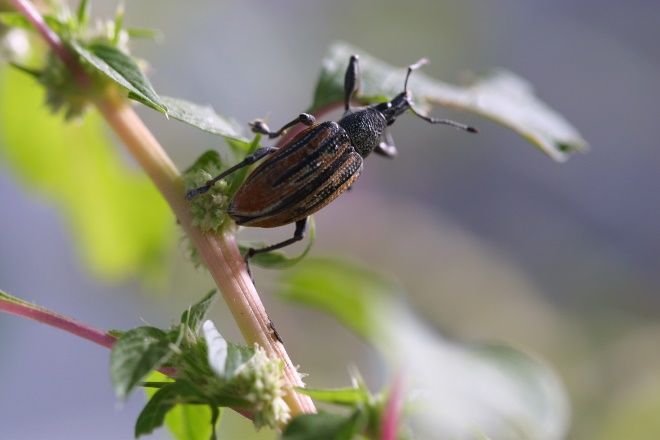
Credit: Calvin Odero, UF/IFAS
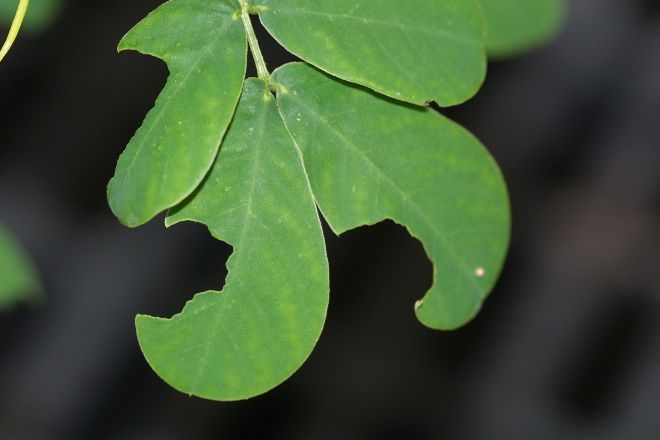
Credit: Calvin Odero, UF/IFAS
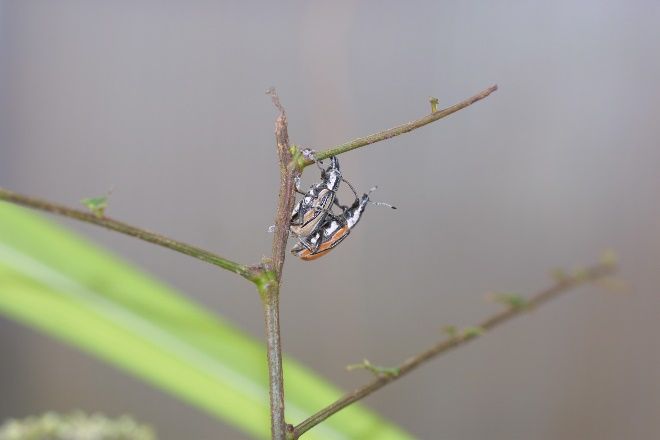
Credit: Calvin Odero, UF/IFAS
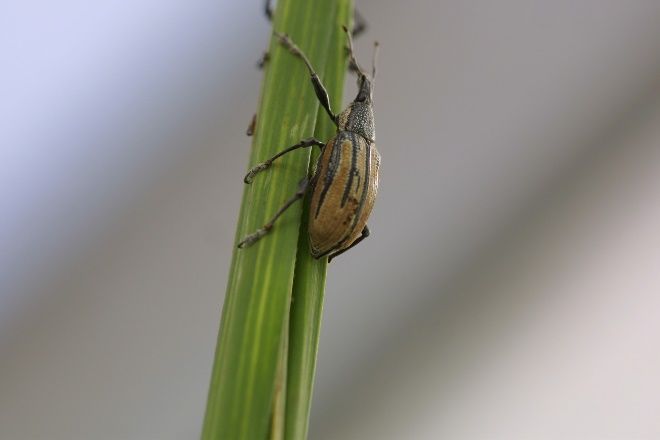
Credit: Calvin Odero, UF/IFAS
Diaprepes Root Weevil and Weed Species Associated with Florida Sugarcane
The Diaprepes root weevil has a wide host range, which includes 270 species in 157 genera across 59 plant families. Associations with these hosts range from adult and larval feeding to oviposition of egg masses (Simpson et al. 1996). Several broadleaf, sedge, and grass weeds infest Florida sugarcane (Figure 5). Broadleaf weeds associated with Florida sugarcane have been shown to be hosts of the root weevil (Odero and Cherry 2013; Odero et al. 2015). Common broadleaf weeds in Florida sugarcane include common lambsquarters (Chenopodium album), spiny amaranth (Amaranthus spinosus), common purslane (Portulaca oleracea), American black nightshade (Solanum americanum), common ragweed (Ambrosia artemisiifolia), ragweed parthenium (Parthenium hysterophorus), morning glories (Ipomoea spp.), coffee senna (Senna occidentalis), and sicklepod (S. obtusifolia) (Rott et al. 2018). More information on these weed species can be found at https://edis.ifas.ufl.edu/publication/PI207.
Although sugarcane can support the entire life cycle of the root weevil (Simpson et al. 1996), it is not a preferred residence or feeding site for adults compared to broadleaf weed species that infest the crop (Odero et al. 2013; Odero et al. 2015). Odero et al. (2013; 2015) showed that adult residence (location) was highest on weed species such as common lambsquarters, common purslane, spiny amaranth, coffee senna, and sicklepod compared to sugarcane. Highest feeding damage also occurred on these weed species preferred for adult residence. Similarly, high adult residence and feeding damage can occur on woody plants such as the invasive Brazilian peppertree (Schinus terebinthifolius) that may grow close to sugarcane fields in Florida.
Although adult root weevil feeding damage to sugarcane leaves is minimal when broadleaf weeds are present, adults will oviposit on sugarcane leaves (Figure 4). Sugarcane is preferred for oviposition compared to weed species, regardless of adult residence or food source. Sugarcane is a poor adult host compared to broadleaf weed species, but is an excellent host for larvae (Simpson et al. 1996), which burrow through the soil and cause root damage to the crop, resulting in fields with stunted, lodged, and upturned plants (Cherry et al. 2011). Such damage can result in total crop failure.
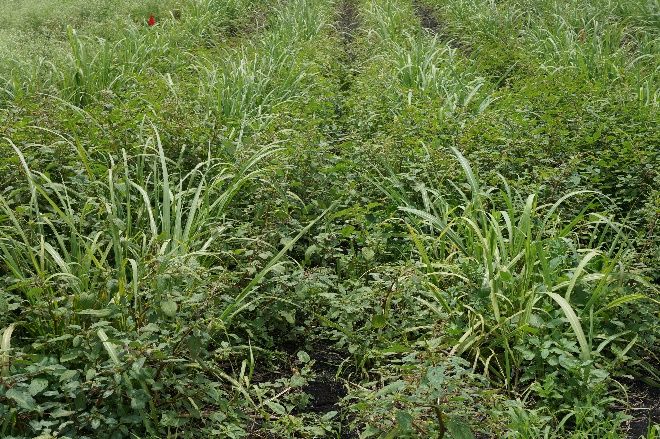
Credit: Calvin Odero, UF/IFAS
Weed Management for Diaprepes Root Weevil Control
Several weed species found in Florida sugarcane are suitable as food sources and oviposition sites for adult root weevils. A front line of defense against the weevil is control of weeds utilized by adults as host plants. Cultural practices such as crop rotation, tillage, and field sanitation can be used to reduce weed infestations in sugarcane. Cultivation is an economical way of suppressing weed growth in sugarcane. It can be done before planting to destroy weeds present in the field and intra-row after sugarcane emergence to supplement chemical weed control. Importantly, cultivation when weeds are not present can encourage the germination of additional weed seeds and reduce the efficacy of soil-applied herbicides if done after herbicide application.
Preemergence and postemergence herbicides can be used to effectively manage weeds, including root weevil host plants. Proper timing of herbicide applications is important for efficacious control of these weed species in sugarcane. Herbicides used for broadleaf weed control in Florida sugarcane include atrazine, metribuzin, mesotrione, 2,4-D amine, dicamba, topramezone, and the premix of atrazine + mesotrione + S-metolachlor. Herbicide applicators must read the label and follow all instructions and precautions carefully to ensure the proper rate, timing, and manner of application.
There are no insecticides labeled for root weevil control in sugarcane compared to other crops such as citrus, where foliar insecticides against adults and soil-applied granular insecticides for larvae can be used. Therefore, when the root weevil infests a sugarcane field, there are limited management options available for growers. Eventually, there is no choice but to repeatedly disk the infested field to kill root weevils before replanting a new crop.
References
Beuzelin, J. M., R. H. Cherry, G. S. Nuessly, and H. S. Sandhu. 2019. Insect Management in Sugarcane. ENY-406. Gainesville: University of Florida Institute of Food and Agricultural Sciences. https://edis.ifas.ufl.edu/publication/IG065
Cherry, R., D. G. Hall, A. Wilson, and L. Baucum. 2011. “First Report of Damage by the Sugarcane Root Weevil Diaprepes abbreviatus (Coleoptera: Curculionidae) to Florida Sugarcane.” Florida Entomologist 94:1063–1065.
Odero, D., R. Cherry, and D. Hall. 2013. "Weedy Host Plants of the Sugarcane Root Weevil (Coleoptera: Curculionidae) in Florida Sugarcane." Journal of Entomological Science 48:81–89.
Odero, D. C., R. H. Cherry, A. L. Wright, H. S. Sandhu, and Y. Luo. 2015. "Woody Host Plants of the Sugarcane Root Weevil (Coleoptera: Curculionidae) in Florida Sugarcane.” Journal of Entomological Science 50:3–13.
Rott, P., D. C. Odero, J. M. Beuzelin, R. N. Raid, M. VanWeelden, S. Swanson, and M. Mossler. 2018. Florida Crop/Pest Profile: Sugarcane. PI-171. Gainesville: University of Florida Institute of Food and Agricultural Sciences. https://edis.ifas.ufl.edu/publication/PI207
Simpson, S. E., H. N. Nigg, N. C. Coile, and R. A. Adair. 1996. “Diaprepes abbreviatus (Coleoptera: Curculionidae): Host Plant Associations.” Environmental Entomology 25:333–349.
Weissling, T. J., J. E. Peña, R. M. Giblin-Davis, and J. L. Knapp, Jr. 2019. Diaprepes Root Weevil, Diaprepes abbreviatus (Linnaeus) (Insecta: Coleoptera: Curculionidae). EENY-024. Gainesville: University of Florida Institute of Food and Agricultural Sciences. https://edis.ifas.ufl.edu/publication/IN151
Woodruff, R. E. 1964. “A Puerto Rican Weevil New to the United States (Coleoptera: Curculionidae).” Florida Department of Agriculture, Division Plant Industry, Entomology Circular 30:1–2.



